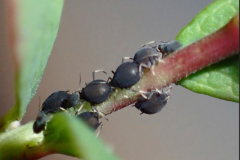Just a minute! Thorne Moors Aphid New to Britain
In the Doncaster Scientific Society [Naturalists’ Society], Minute Book for 1950-1967 the minutes of the Ordinary Meeting on 17 October 1950 record that Mr A.A. Dallman reported that aphids he collected on Andromeda polifolia on his visits to Thorne Waste in 1932 and 1933 had been confirmed as Aphis vaccinii, the Dark Bilberry Aphid, a species then new to Britain.
On a scrap of headed notepaper [from The Grammar School, Dorchester, Dorset] Dallman had typed an account describing the laborious saga of the record being confirmed and published. This notepaper, later Sellotaped into the minute book, reads as follows:
“A Visit to Thorne Waste 23 July 1932 revealed a distinctive aphid associated with Andromeda polifolia L., the attractive Bog-bell or Wild Rosemary. Two subsequent visits were made in the following year (June 10 and 17) when the insect was fairly plentiful and both alate [winged] and apterous [immature or wingless] forms were obtained. Despite careful search of Ling Calluna vulgaris Salisb. and associated plants on all three occasions I failed to find the creature on any other food plant and it was obvious that Andromeda polifolia was the favoured host hereabouts. There was no evidence of galling.
Being unable to come up with any decision on the identity of the parasite which appeared to have some resemblance to Theobald’s Aphis callunae, the Heather Aphid, I sought the views of Dr. F. Laing (Brit. Mus. Nat. Hist.). He was at first inclined to the opinion that the specimens represented an undescribed species. After subsequent examination of further examples which I obtained in 1933 he wrote:- After a great deal of hesitation I came to the conclusion that the Andromeda’s aphis was Aphis callunae. Feeling that further investigation was desirable I published a note on the subject in the hope that further observations and cultural experiments would be welcome and should yield useful information.
In July of 1949 an Otley (Yorkshire) observer met with some apterous [wingless] aphids on seedlings of the North American Blueberry, Vaccinium vacillans Kalm. at Otley. These were sent to my friend Dr. J.H. Fidler (National Agricultural Advisory Service, Ministry of Agriculture and Fisheries, Leeds) and seemed to fit the description given by Theobald for Aphis callunae. Further examination of additional material from the Otley plants by Mr. H.L.G. Stroyan elicited the opinion that the insect was Aphis vaccinii, a species described by Börner in 1940 and not previously recorded for Britain.
Examination of Börner’s very brief description showed that he recorded Andromeda polifolia L. as one of the host plants. Dr. J.H. Fidler then recalled my earlier Yorkshire record of aphids on this plant and Dr. Laing’s hesitant view thereon. Dr. Fidler was given the opportunity by Dr Laing of examining this material which proved to be undoubtedly the same species as that found at Otley so recently.
Comparison was also made with slides of A. callunae, including the Type specimen and it was concluded that the two species, although very close, differed in a number of characters unlisted in both Börner’s and Theobold’s desceiptions. It was therefore decided that a re-description of A, vaccinii was called for, especially as Börner’s description of the apterae consists of about a dozen words and the alatae of neither species appear to have been noted before.”
The result of this investigation appears in Fidler, J.H. (1951) Aphis vaccinii (Börner) (Hemiptera, Aphididae) new to the British Isles. A re-description and comparison with Aphis callunae Theobald. Proceedings of the Royal Entomological Society of London Vol.1 (Parts 3-4): 37-43.
Although the meticulously thorough Peter Skidmore included Aphis vaccinii in his monumental An Inventory of the Invertebrates of Thorne and Hatfield Moors (2006) Thorne & Hatfield Moors Monograph No. 2., the appendix entry on page 85 in no way reflects the blood, sweat and tears expended by Dallman, Laing, Fidler and Stroyan in confirming the record, also the literature reference is new.
C.A.Howes
P.S. This most byzantine piece of research illustrates how members of the Doncaster Nats were working at the frontiers taxonomy [as are Tom Higginbottom; Ian Farmer and Louise Hill today] and how connected they were with entomologists across the UK. It also illustrates the laborious difficulties of working pre Internet.
It also shows why cataloguing the archives is such a slow but utterly fascinating process.
If 1940 was the date when the species was described and accepted as a new taxa, it implies that Dallman’s 1932-33 Thorne Moors specimens were the first specimens ever to be encountered !!!
It’s a pity Arthur Augustine Dallman didn’t publish his finds with a description, calling them Aphis thornemoorsensis.
C.A.H.
